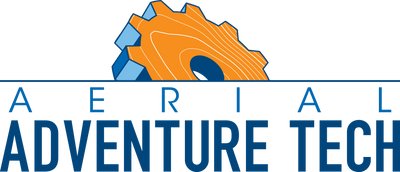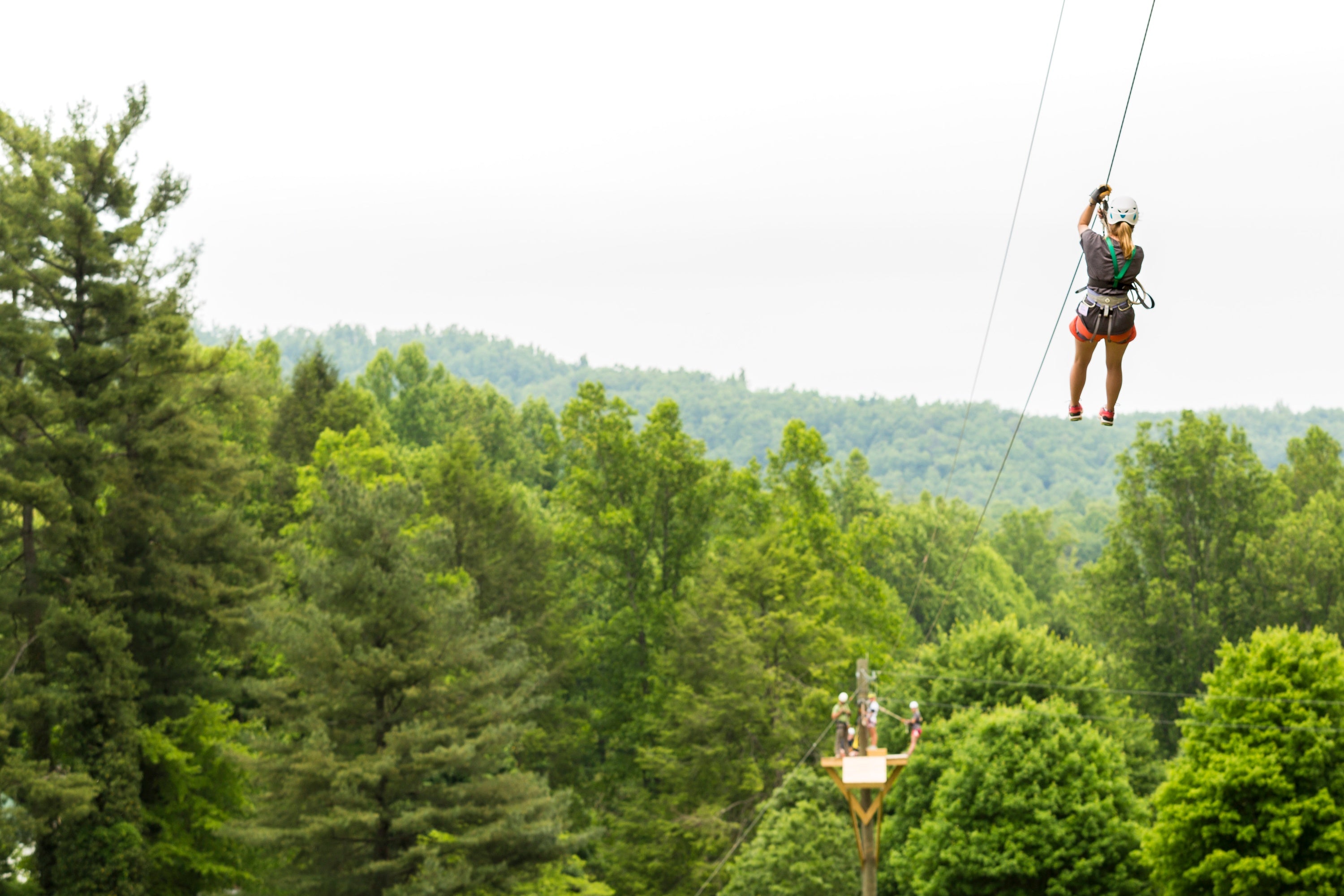Zip lines are the center-piece of many commercial aerial park and camp-based adventure programs offering exhilarating adventure experiences to a wide range of ages and abilities. Managing and maintaining zip lines and the associated equipment are essential to managing risk and getting the most value from your investment. While your annual third-party inspection provides invaluable assessment once a year, a robust internal maintenance program keeps you informed year round and prevents small issues from becoming big problems. This blog will explore the essentials of zip line maintenance, environmental considerations, the use of compliance-grade equipment, technological advancements, and buying recommendations.
The Essentials of Zip Line Equipment Maintenance
Having an established and ongoing inspection and maintenance plan supports safe and efficient operations. Operators should develop their own inspection and maintenance criteria and intervals in conjunction with the facility manufacturer or other qualified vendor. Any work performed on zip lines and other critical facility components should always be done under the supervision of a qualified professional As with any life-safety system, contact a qualified vendor any time a component is suspected of being non-conforming. Here are some of the the key components to focus on during ongoing checks.
- Zip Lines
- Review incident reports and survey staff about changes in the function or performance of the zip line and any associated components.
- Inspect the entire length of cable for signs of:
- Abrasion, wear, flattening, or distortion of the cable strands, particularly at points of high contact like mid-span and near platforms.
- Broken wires, fraying, penetrating rust, or other corrosion.
- Assess for any unintended points of contact with trees, structures, or other features.
- Verify that riders arrive at a controlled rate to the receiving end and at the proper elevation relative to the receiving-side structure.
- Consult with a professional vendor regarding fluid film treatment and other in-house corrosion mitigation and maintenance steps for your zip lines.
- Trolleys
- Visually inspect the trolley frame and components for signs of stress, cracking, corrosion, or deformation.
- Ensure all fasteners are secure, and that all gates, locking features, and spring-assist functions operate as intended.
- Assess the trolley wheels for excessive wear, flat spots, or cracks.
- Spin the wheels to ensure smooth and wobble-free rotation with no unusual noise or resistance.
- Clean the trolley with a damp cloth and mild detergent. Use a brush to remove any hard-to-get particulates. Clean around the bearing seals carefully to prevent dirt and debris from entering the bearing assembly.
- Add small amounts of lubricant per manufacturer recommendations. Since sealed bearings are designed to be maintenance-free and pre-lubricated, avoid adding lubricants directly to the bearings. Always refer to the manufacturer's maintenance guidelines and follow their specific recommendations for your trolley model.
- Anchor Points and Platforms
- Inspect anchor points for wear, deformation, or excessive corrosion, and ensure that all faces, bolts, nuts, and connectors are secure, seated, and flush with their mounting surface.
- Ensure cables are inline with anchor points and maintain a straight-line load unless otherwise specified by the manufacturer. Check for the absence of movement or shifting of anchor points under load.
- Inspect structural components of platforms including support beams and decking looking for signs of rot, rust, or other degradation.
- Brake Systems
- Review incident reports and survey staff about changes in the function or performance of the zip line brake and any associated components.
- Inspect brake blocks for signs of wear or deformation and ensure the blocks fit securely over the cable and make proper contact with the zip trolley.
- Inspect all attachment and rigging points for wear, corrosion, or damage and test the brake block to ensure consistent engagement and braking force.
- For automated zip line braking systems:
- Ensure all mandatory inspections, service, and maintenance have been performed per the manufacturer’s instructions.
- Check the main unit and all interconnected components for signs of wear or damage.
- Test the unit to ensure that it operates within the manufacturer's specification and that the brake block resets after each use.
- Replace worn brake ropes, pulleys, and other components that can add unwanted friction in both automated and guide-operated systems.
By regularly inspecting and assessing your zip line systems and components, you can identify maintenance priorities and budget accordingly. Check out Challenge Tower's Gear Care and Cleaning Guide for tips on prolonging the life of your equipment.

Environmental Considerations
Environmental factors significantly influence the wear and performance of zip line equipment making tailored inspection and maintenance practices essential.
During harsh winters, inspect metal components for rust and corrosion, apply approved anti-corrosion treatments as needed, and ensure parts are dry before storage. Clear ice and snow from cables, platforms, and braking systems to prevent slippage, improper function, and damage caused by excess weight. In very cold conditions, regularly check for brittleness or cracking of plastic and rubber components.
In hot climates, thermal expansion can affect cable tension and alignment. Regularly inspect cables and address any concerns with a professional vendor. Monitor harnesses, webbing, and other soft goods for excess UV exposure. In forested areas, frequently remove debris from cables and platforms and trim vegetation to prevent damage and interference.
Coastal locations require regular inspections for salt corrosion on metal components, application of anti-corrosion treatments, and proper lubrication of moving parts.
In dry, dusty environments, clean components regularly to remove abrasive debris and use protective covers for sensitive parts.
Regular inspections, preventive maintenance schedules, and thorough staff training tailored to local environmental challenges enhance the safety, performance, and longevity of zip lines and related equipment. Here are 8 pre-season steps for managing aerial adventure equipment.
Compliance and Equipment Selection
Selecting the right equipment and ensuring it meets high standards is critical for managing safe and efficient zip line operations. Proper equipment selection and maintenance directly impact reliability and longevity of zip line components.
Ensuring compliance with ANSI standards is crucial when selecting safety gear for your staff. Use ANSI-compliant gear such as harnesses, helmets, lanyards, and other equipment to guarantee maximum protection and reliability. Regularly train staff on the proper use and inspection of this gear to maintain high safety standards. For more details, check out our blog on ANSI-rated gear.
When selecting participant equipment, prioritize high-quality gear that is well-suited to your facility's operational and environmental conditions. For example, choose UV-resistant materials for sunny climates, corrosion-resistant gear for coastal areas, and equipment that can withstand temperature fluctuations in regions with varying weather conditions. Additionally, ensure the selected equipment is appropriate for the range of participant sizes and weights, providing a comfortable and secure fit for all users.
Regularly review and update your equipment choices based on industry best practices and any changes in your facility's environment or usage patterns. This proactive approach helps maintain a safe and enjoyable experience for both staff and participants that is tailored to the unique requirements of your site.

Technological Advancements and Staying Current
Staying updated with technological advancements can greatly enhance your zip line operations. Modern equipment offers improved safety features, better performance, and enhanced user experiences. Here are some technological advancements to consider:
- Automated Brake Systems: These systems provide consistent and controlled braking for zip line riders. These systems can accommodate a wide variety of rider weights and speeds, helping to regulate smooth deceleration while eliminating the need for the rider to participate in braking, reducing the risk of human error. Automated braking systems reset after each ride for enhanced efficiency and throughput.
- Access Control: One example of an access control system is the C-PASS ZiP. These systems reduce the risk of collisions on self-navigating zip lines by blocking trolley access when a zip line is occupied. Battery-operated mechanical trolley gates are positioned on either side of the zip line, preventing access when the line is in use. Some models also include remote control options for added convenience and control.
- Advanced Trolleys: Modern trolleys significantly enhance the zip line experience through advanced design and functionality. Anti-rollback trolleys prevent riders from sliding backward, while speed-restricted trolleys ensure that riders maintain a consistent, safe speed throughout their ride. Trolleys designed for specific brake systems integrate for optimal braking performance.
Staying current with technological advancements not only helps mitigate risks and improve safety but also enhances operational efficiency and the longevity of equipment. Operators can boost overall success and provide superior participant experiences by staying current with tech trends and incorporating relevant innovations
The Buying Guide
Aerial Adventure Tech offers a wide range of equipment for zip line operations. Don’t see what you're looking for? No problem — contact us and we can help connect you with the right equipment for the job. Here is a quick list of some of our top-selling zip line equipment collections:
Trolleys
Our collection of trolleys includes options with high-grade bearings and robust construction, designed for durability and smooth operation. You’ll find trolleys compatible with various cable sizes and integrated with advanced braking systems to improve safety and reliability.
Gloves
The gloves collection features high-quality options designed to provide enhanced grip and comfort. These gloves are ideal for frequent use, offering improved control and protection for both riders and operators.
Zip Lines
Our zip line collection is extensive, including everything from helmets and harnesses to ropes, connectors, and carabiners. You'll also find a variety of accessories designed to enhance safety and performance, such as pulleys, brake systems, and trolley attachment points. This broad selection ensures that you can outfit your zip line setup with high-quality, durable gear suited to your specific needs.
Radio Harnesses
Our radio harnesses are designed for comfort and convenience, keeping communication devices secure and easily accessible. These harnesses are essential for maintaining clear communication during zip line operations.
Packs & Bags
In the packs and bags collection, you'll find durable and spacious options for storing and transporting rescue systems, lift-and-lower kits, and more. These bags help keep your gear organized and protected from the elements.
Regular maintenance and smart purchasing decisions are essential for the safety and longevity of your zip line setup. By focusing on routine inspections, adapting to environmental conditions, using compliance-grade equipment, and staying current with technological advancements, you can provide a safe and enjoyable experience for all.

